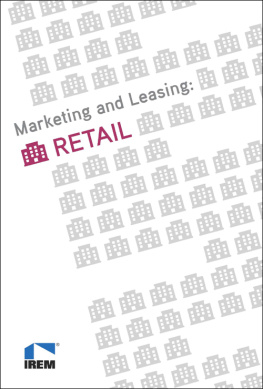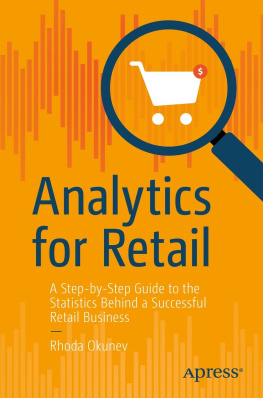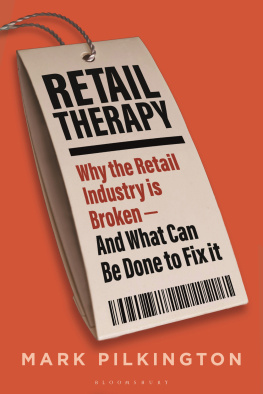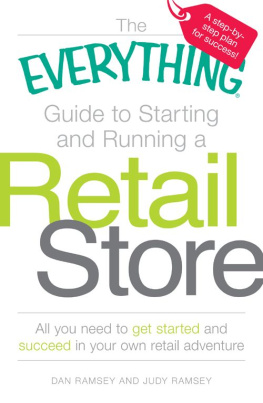
rd Edition
T ABLE OF CONTENTS
ISBN 0-9739-1411-4
Copyright 2003-2012, DMSRetail Inc., All rights reserved
Serial Number : DMSRM-3045R454P9549
RETAIL MATH MADE SIMPLE
INTRODUCTION
Many decisions, affecting operations at store level, are misunderstood by district and store personnel. In many cases, even when havoc is created, had the decision been understood it would have alleviated much frustration; allowing the store manager to pass the information on to their staff in an intelligent fashion.
When understanding is lacking people have no alternative but to put their own ideas and perceptions into play; into the forefront. Unfortunately, this is not usually productive and often the point of the exercise or the result desired doesnt have a chance of success.
To many retail managers a bad decision made, an unproductive process put into place or an unbelievable policy implemented simply confirms, to them, that Head O ffice personnel need to spend more time in the stores so they can see whats really going on. Of course, this may sometimes be true many H ead O ffice employees would benefit tremendously by spending more time in the stores and retail comp anies should insist that their Head O ffice employees spend a specified amount of time in stores every month. However, the truth is that most H ead O ffice employees do know what theyre doing. Decisions affecting your retail store, good or bad, usually have some analysis behind them. And, usually, that analysis involves retail math.
Understand some retail math and you shall have new insight into what is going on around you.
We are not suggesting that all retail store employees must be made aware of the details behind every decision. That would be unreasonable and unnecessary. What we are suggesting is that people should be given the information that makes sense to them; information that will help them to understand how their working world turns. The goal should be to avoid confusing people, avoid the problems associated with unsubstantiated rumors and help people to draw correct conclusions.
So here you are. You have decided to learn something about retail math in order to become more adept at understanding how your whole business operates and, more importantly how to interpret what is going on so you can communicate positively to your staff.
You and your staff are, after all, the people meeting with the customer every day and you all need to be in the loop to some extent.
Great! Lets get started
GLOSSARY OF TERMS
Although it is the norm to provide a Glossary of Terms at the end of a book, we believe it will be more useful to the reader to have an understanding of some of the terms used before they see them as part of a calculation.
Here they are:
Accounts Payable:
The amount owing to suppliers of merchandise and/or services that were purchased on account.
Accounts Receivable:
The amount that others owe you to pay for merchandise and/or services that were purchased on account.
Average Sale per Customer OR Average Sale per Transaction
The average dollar amount of one sale to one customer OR the average dollar amount of one sale in one transaction. These are the same but may
be expressed differently. One transaction is deemed to be associated with one customer.
Conversion Rate:
The rate at which customers coming into the store are converted into buying customers.
Current Assets:
This is a classification shown on the Balance Sheet. Current Assets include cash, inventory and accounts receivable. Current Assets are considered to be quite liquid which means that they can be readily converted to cash. Other assets, such as properties, fixtures, etc. are considered Fixed Assets and cannot be converted to cash nearly as quickly as Current Assets. Fixed Assets are shown as a separate classification on the Balance Sheet.
Current Liabilities:
Any debt owing during the current period. This would include Accounts Payable to suppliers of merchandise and/or services and loans; usually bank loans.
Customer Traffic:
This is simply the number of people passing through the doors of the retail store. Some companies install traffic counters to count the people coming and going. The traffic counter is usually set high enough to avoid counting the children coming through the doors as they cannot reasonably be expected to make a purchase, depending on the business of course. Information is taken from the traffic counter and downloaded usually to the Head Office via polling and is then used to make specific calculations regarding conversion rates.
Discounts Taken:
Suppliers of merchandise and/or services generally offer special discounts to reward the retailer for paying their invoices quickly or for buying large quantities. There can be other discounts available and retailers would negotiate terms with the supplier before placing their orders.
FTE Employee:
FTE stands for Full Time Equivalent. Many retailers hire few full time staff members and many part time staff members. In order to work with certain indicators, or measures, it is necessary to standardize. For instance, if a full time employee regularly works forty hours per week and part time employees work only 20 hours it would take two part time employees to make a Full Time Equivalent, or FTE.
Gross Margin :
Net Sales minus Cost of Goods Sold, also referred to often as COGS. The Cost of Goods Sold includes the cost as stated on the invoice as well as any applicable warehousing or distribution costs directly attributable to the merchandise.
Inventory Carrying Costs:
Any costs incurred as a result of possessing the inventory. These include, but are not limited to: cost of the space used for storage, cost of handling the inventory, interest owed on the investment, cost of insuring the inventory.
Liquidity:
The ability to generate cash quickly. This includes converting assets to cash quickly.
Markdowns:
Reduction of selling price. This is generally done to help move, or sell, merchandise that is not moving quickly enough at the first price (cost plus initial retail mark up).
Net Profit:
Total income minus total expenses.
Net Sales:
Gross sales minus any returns and allowances given.
Number of Transactions:
The total number of transactions processed. One sale to one customer is considered to be one transaction.
Occupancy Cost:
All costs incurred as a result of occupying a property. These include, but are not limited to: rent, in- store maintenance and common area
maintenance, insurance, h eat, hydro and other utilities, building/equipment depreciation expense, taxes.
Operating Cost :
All of the costs to operate the business. The cost of merchandise and any financing costs are not considered operating costs.
Open to Buy :
The dollar value of merchandise that may be purchased according to pre-determined limits based on sales expectations.
Returns and Allowances:
The dollar value of merchandise returned by customers.
Shareholders Equity (also referred to as Owners Equity):
The amount of money invested by the individuals who own the business.
Shrinkage:
Shrinkage is the difference, in dollars, between the amount of inventory on the books (which you should have ) and the actual physical count (which you do have ).
Shrinkage is considered to be the result of theft, both internal (employees) and external (shoplifters/thieves), and paperwork errors. Damaged merchandise can also be considered shrinkage but most companies have processes in place to record these damages and the total dollars recorded are used to adjust the shrinkage number.
Next page










